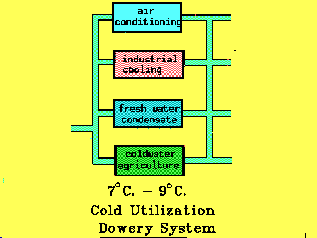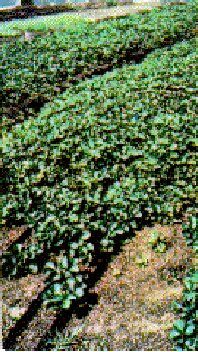THE COLD UTILIZATION SUBSYSTEM
COLD UTILIZATION

The second subsystem - cold utilization is depicted in th illustration Here
the most economically valuable use of deep ocean water appears in the form of
air conditioning and industrial cooling. Conventional means of cooling are in
fact forms of reverse OTEC. As a consequence they pay a heavy Carnot efficiency
penalty. On the average these systems generate ten times as much heat as they
remove in terms of cold.. The Natural Energy Laboratory makes extensive use of
this efficiency in all of its cooling processes. A simple double pipe heat
exchanger which substitutes for the refrigeration equipment was employed for our
main laboratory building. The cost of the double pipe replacement is several
hundred dollars and required no engineering of any sophistication. The monthly
savings in cost for this building are approximately $3000.00 from a previous
total bill of about $3,500.00. Large areas of the industrial world such as the
West Coast of the United States could realize huge savings in energy costs, in
CO2 generation and in restoration of the microclimate of major cities. In small
villages where air conditioning is considered a luxury, the major energy use
appears in the cooling facilities for fisheries and other perishable food items.
As will be shown the need for such cooling and cold storage facilities will be
greatly increased as the deep ocean water is employed for aquaculture and
agriculture.
Another major cold utilization for deep ocean water is in the generation of
fresh water and other distillation and fermentation processes. Classical
approaches to this generation focus on evaporation of surface waters utilizing
high vacuum Figure 16 and condensation with deep ocean water. This techniques
energy efficient but requires moderately sophisticated and expensive technology.
Less efficient but simpler are the use of elemental condensation plates. In its
simplest form condensation is removed from heat exchanger modules manufactured
by roll bonding techniques. Thus low cost units whose cost are order of
magnitude $100.00 can produce from fifteen to thirty gallons of distilled water
per day. In places like Christmas Island or Cape Verde where potable water is at
a premium this simple technique can easily provide self sufficiency. Most
recently there has been designed and patented a tower that simulates a hurricane
The Hurricane Tower which
produces water as a hurricane produces water.
 But condensation techniques coupled with biophysical
applications of cold have produced a surprising result in terms of agriculture
in coastal desert areas. Quite simply black plastic irrigation pipe is embedded
in agricultural soil at a depth which corresponds to the root depth of the
species to be cultivated. Deep ocean water is passed through these pipes and
heavy condensation is induced. An inadvertent happening in the early development
of this process demonstrated the potential for organic gardening with minimum
attention for a wide variety of valuable agricultural crops. In this instances a
field of strawberry plants were prepared in accordance with the coldwater
(Coldag) technique. For unexpected personal reasons the individual who was
assigned the task of tending the beds was absent for a period of four months.
With minimum tending by volunteers the strawberry plants proliferated in a
healthy ground cover as shown in this historic picture. Of particular
significance was the growth of the strawberry plants beyond the prepared beds
along the exposed coldwater pipes. This demonstrates beyond any doubt that the
growth mechanism relates to the cold and the condensate produced by the process.
When this environmentally sustainable organic form of garden was recognized a
cooperative farm was formed with volunteer who agreed to develop a wide variety
of crops. Surprisingly almost every species produce crops of high quality
unusual sweetness and rapid growth. It is now recognized that the thermodynamic
processes in plant growth play a major role in the transport of phosphates and
nitrates to the fruiting and vegetation areas and that the production of high
energy products such as sugar is highly dependent upon temperature differences
along the transport path of these nutrients. Thus the application of cold in the
root area of spring crops produces unusually sweet fruit while it is known that
the application of cold to the ripening of fall fruits has a similar result. As
a consequence tests are being conducted with modifications of the air
temperature as well as root temperature. More than seventy five crops with
varying locations of cold application have now produced in a span of only five
months. The section on Cold
Water Agriculture depicts a number of these successful products.
But condensation techniques coupled with biophysical
applications of cold have produced a surprising result in terms of agriculture
in coastal desert areas. Quite simply black plastic irrigation pipe is embedded
in agricultural soil at a depth which corresponds to the root depth of the
species to be cultivated. Deep ocean water is passed through these pipes and
heavy condensation is induced. An inadvertent happening in the early development
of this process demonstrated the potential for organic gardening with minimum
attention for a wide variety of valuable agricultural crops. In this instances a
field of strawberry plants were prepared in accordance with the coldwater
(Coldag) technique. For unexpected personal reasons the individual who was
assigned the task of tending the beds was absent for a period of four months.
With minimum tending by volunteers the strawberry plants proliferated in a
healthy ground cover as shown in this historic picture. Of particular
significance was the growth of the strawberry plants beyond the prepared beds
along the exposed coldwater pipes. This demonstrates beyond any doubt that the
growth mechanism relates to the cold and the condensate produced by the process.
When this environmentally sustainable organic form of garden was recognized a
cooperative farm was formed with volunteer who agreed to develop a wide variety
of crops. Surprisingly almost every species produce crops of high quality
unusual sweetness and rapid growth. It is now recognized that the thermodynamic
processes in plant growth play a major role in the transport of phosphates and
nitrates to the fruiting and vegetation areas and that the production of high
energy products such as sugar is highly dependent upon temperature differences
along the transport path of these nutrients. Thus the application of cold in the
root area of spring crops produces unusually sweet fruit while it is known that
the application of cold to the ripening of fall fruits has a similar result. As
a consequence tests are being conducted with modifications of the air
temperature as well as root temperature. More than seventy five crops with
varying locations of cold application have now produced in a span of only five
months. The section on Cold
Water Agriculture depicts a number of these successful products.
After the deep ocean water has been employed in one or more cold utilization
applications it can be utilized again for the residual cold (about 13 degrees C)
and the nutrients.

 But condensation techniques coupled with biophysical
applications of cold have produced a surprising result in terms of agriculture
in coastal desert areas. Quite simply black plastic irrigation pipe is embedded
in agricultural soil at a depth which corresponds to the root depth of the
species to be cultivated. Deep ocean water is passed through these pipes and
heavy condensation is induced. An inadvertent happening in the early development
of this process demonstrated the potential for organic gardening with minimum
attention for a wide variety of valuable agricultural crops. In this instances a
field of strawberry plants were prepared in accordance with the coldwater
(Coldag) technique. For unexpected personal reasons the individual who was
assigned the task of tending the beds was absent for a period of four months.
With minimum tending by volunteers the strawberry plants proliferated in a
healthy ground cover as shown in this historic picture. Of particular
significance was the growth of the strawberry plants beyond the prepared beds
along the exposed coldwater pipes. This demonstrates beyond any doubt that the
growth mechanism relates to the cold and the condensate produced by the process.
When this environmentally sustainable organic form of garden was recognized a
cooperative farm was formed with volunteer who agreed to develop a wide variety
of crops. Surprisingly almost every species produce crops of high quality
unusual sweetness and rapid growth. It is now recognized that the thermodynamic
processes in plant growth play a major role in the transport of phosphates and
nitrates to the fruiting and vegetation areas and that the production of high
energy products such as sugar is highly dependent upon temperature differences
along the transport path of these nutrients. Thus the application of cold in the
root area of spring crops produces unusually sweet fruit while it is known that
the application of cold to the ripening of fall fruits has a similar result. As
a consequence tests are being conducted with modifications of the air
temperature as well as root temperature. More than seventy five crops with
varying locations of cold application have now produced in a span of only five
months. The section on Cold
Water Agriculture depicts a number of these successful products.
But condensation techniques coupled with biophysical
applications of cold have produced a surprising result in terms of agriculture
in coastal desert areas. Quite simply black plastic irrigation pipe is embedded
in agricultural soil at a depth which corresponds to the root depth of the
species to be cultivated. Deep ocean water is passed through these pipes and
heavy condensation is induced. An inadvertent happening in the early development
of this process demonstrated the potential for organic gardening with minimum
attention for a wide variety of valuable agricultural crops. In this instances a
field of strawberry plants were prepared in accordance with the coldwater
(Coldag) technique. For unexpected personal reasons the individual who was
assigned the task of tending the beds was absent for a period of four months.
With minimum tending by volunteers the strawberry plants proliferated in a
healthy ground cover as shown in this historic picture. Of particular
significance was the growth of the strawberry plants beyond the prepared beds
along the exposed coldwater pipes. This demonstrates beyond any doubt that the
growth mechanism relates to the cold and the condensate produced by the process.
When this environmentally sustainable organic form of garden was recognized a
cooperative farm was formed with volunteer who agreed to develop a wide variety
of crops. Surprisingly almost every species produce crops of high quality
unusual sweetness and rapid growth. It is now recognized that the thermodynamic
processes in plant growth play a major role in the transport of phosphates and
nitrates to the fruiting and vegetation areas and that the production of high
energy products such as sugar is highly dependent upon temperature differences
along the transport path of these nutrients. Thus the application of cold in the
root area of spring crops produces unusually sweet fruit while it is known that
the application of cold to the ripening of fall fruits has a similar result. As
a consequence tests are being conducted with modifications of the air
temperature as well as root temperature. More than seventy five crops with
varying locations of cold application have now produced in a span of only five
months. The section on Cold
Water Agriculture depicts a number of these successful products.